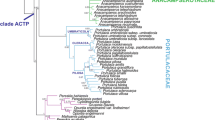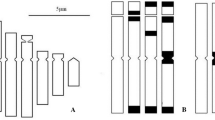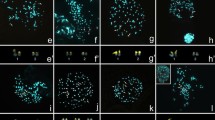Abstract
Various species ofTaxodiaceae were selected for chromosome studies to indicate cytotaxonomic and phylogenetic relationships. Point dispersal patterns of diagrammatic presentations of the species' karyotypes, rather than marker chromosomes, were found to be the most significant cytotaxonomic characteristic in indicating phylogenetic relationships. Karyotypic evolution inTaxodiaceae appears to occur by unequal reciprocal translocations followed by pericentric and paracentric inversions. Cytotaxonomic relationships among species generally correspond to the phylogenetic relationships withinTaxodiaceae indicated by classical taxonomic classification. Presence and types of marker chromosomes may have the potential to indicate relationships between different coniferous families.
Similar content being viewed by others
References
Alvin, K. L., Boulter, M. C., 1974: A controlled method of comparative study for Taxodiaceous leaf cuticles. — Bot. J. Linn. Soc.69, 277–286.
Arnold, C. A., 1952: Paleobotanical investigations in Naval Petroleum Reserve No. 4, Alaska. — Science116 (3003), 61–62.
—, 1955: A new cretaceous conifer from northern Alaska. — Amer. J. Bot.42, 522–528.
Brown, R. W., 1935: Some fossil conifers from Maryland and North Dakota. — J. Wash. Acad. Sci.25, 441–450.
—, 1936: The genusGlyptostrobus in America. — J. Wash. Acad. Sci.26, 353–357.
Buchholz, J. T., 1939: The generic segregation of the sequoias. — Amer. J. Bot.26, 535–538.
—, 1948: Generic and subgeneric distribution of theConiferales. — Bot. Gaz.110, 80–91.
Butala, J. R., 1973: Investigations ofGlyptostrobus, a taxodiaceous conifer. — Ph.D. Thesis, Washington State University (U.S.A.).
Butts, D., Buchholz, J. T., 1940: Cotyledon numbers in conifers. — Trans. Illinois State Acad. Sci.33, 58–62.
Chamberlain, C. J., 1935: Gymnosperms, Structure and Evolution. — Chicago: University of Chicago Press.
Chaney, R. W., 1951: A revision of fossilSequoia andTaxodium in western North America based on the recent discovery ofMetasequoia. — Trans. Amer. Philos. Soc., n.s.40, 169–263.
Darlington, C. D., Wylie, A. P., 1955: Chromosome Atlas of Flowering Plants. — London: George Allen and Unwin.
Dayton, W. A., 1943: The names of the giant sequoia. — Leaflets West. Bot.3, 209–219.
DeLaubenfels, D. J., 1953: The external morphology of coniferous leaves. — Phytomorphology3, 1–20.
Doyle, J., 1945: Naming of redwoods. — Nature155, 254–257.
Eckenwalder, J. E., 1976a: Re-evaluation ofCupressaceae andTaxodiaceae: a proposed merger. — Madrono23, 237–256.
—, 1976b: Comments on “A new classification of the conifers.” — Taxon25, 337–339.
Ehrendorfer, F., 1976: Evolutionary significance of chromosomal differentiation patterns in gymnosperms and primitive angiosperms. — InBeck, C. B., (Ed.): Origin and Early Evolution of Angiosperms, 220–240. — New York: Columbia University Press.
Endo, S., 1952: A record ofSequoia from the Jurassic of Manchuria. — Bot. Gaz.113, 228–230.
Endo, T. R., Gill, B. S., 1984: Somatic karyotype, heterochromatin distribution and structural chromosome differentiation in common wheat,Triticum aestivum L. em.Thell. — Chromosoma (Berl.)89, 361–369.
Florin, R., 1922: On the geological history of theSciadopitineae. — Svensk. Bot. Tidskr.16, 260–270.
—, 1940: The tertiary fossil conifers of South Chile and their phytogeographical significance. With a review of the fossil conifers of southern lands. — K. Svenska Vetensk. Akad. Handl.3, 19(2), 1–107.
—, 1952: OnMetasequoia, living and fossil. — Bot. Not.1951, 1–29.
Florin, R., 1960: Die frühere Verbreitung der KoniferengattungAthrotaxis D. Don. — Senckenbergiana Lethaea41, 199–207.
—, 1963: The distribution of conifer and taxad genera in time and space. — Acta Horti Berg.20, 121–312.
Greguss, P., 1955: Identification of Living Gymnosperms on the Basis of Xylotomy. — Budapest: Akadémiai Kiadó.
Gulline, H. F., 1952: The cytology ofAthrotaxis. — Pap. & Proc. Roy. Soc. Tasmania86, 131–136.
Hair, J. B., 1968: The chromosomes of theCupressaceae 1.Tetraclineae andActinostrobeae (Callitroideae). — N. Z. J. Bot.6, 277–284.
Hayata, B., 1931: TheSciadopityaceae represented bySciadopitys verticillata Sieb. & Zucc., an endemic species of Japan. — Bot. Mag.45, 567–569, (Japanese).
—, 1932: TheTaxodiaceae should be divided into several distinct families, i.e. theLimnopityaceae, Cryptomeriaceae, Taiwaniaceae, and theCunninghamiaceae; and furtherTetraclinis should represent a distinct family, theTetraclinaceae. — Bot. Mag.46, 24–27, (Japanese).
Henry, A., McIntyre, M., 1926: The swamp cypresses,Glyptostrobus of China andTaxodium of America with notes on allied genera. — Proc. Royal Irish Acad.37, sect. B, 13, 90–116.
Hida, M., 1952: The affinity ofMetasequoia to other conifers as shown by the number of protoxylem in roots. — Bot. Mag.65, 280–287, (Japanese with English summary).
—, 1957: The comparative study ofTaxodiaceae from the standpoint of the development of the cone scale. — Bot. Mag.70, 44–51, (Japanese with English summary).
—, 1962: The systematic position ofMetasequoia. — Bot. Mag.75, 316–323, (Japanese with English summary).
—, 1962: Studies on the sugars in the leaves of conifers. — Bot. Mag.75, 153–157, (Japanese with English summary).
Hirayoshi, I., Nakamura, Y., 1943: Chromosome number ofSequoia sempervirens. — Bot. Zool.2, 72–75, (Japanese with English summary).
Hunziker, J. H., 1958: Karyotype analysis inCupressus andLibocedrus. — Proc. 10th Int. Congr. Genet. McGill University, Montreal, Canada2, 128–129.
—, 1961: Estudios cromosomicos enCupressus yLibocedrus. — Revista de Investigaciones Agricolas15 (2), 159–185.
Jensen, H., Levan, A., 1941: Colchicine-induced tetraploidy inSequoia gigantea. — Hereditas27, 220–224.
Johnson, L. C., Ward, M. F., 1972: Male cone production inMetasequoia glyptostroboides growing at the Dominican College of San Rafael, California. — Calif. Hort. J.33, 98–119.
Jones, G. N., 1943: The botanical name of the giant sequoia. — Science98, 406–407.
Khoshoo, T. N., 1959: Polyploidy in gymnosperms. — Evolution13, 24–39.
—, 1961: Chromosome numbers in gymnosperms. — Silvae Genet.10, 1–9.
—, 1963: The chromosomes and relationships ofWelwitschia mirabilis. — Chromosoma (Berl.)14, 522–533.
Kurabayashi, M., 1958: Evolution and variation in Japanese species ofTrillium. — Evolution12, 286–310.
Kurita, M., 1953: A study of the chromosomes inNothoscordum fragrans (Vent.)Kunth. — Mem. Ehime Univ.1, 55–63.
—, 1960: Nucleolar chromosome with a long centromere. — Rep. Biol. Inst. Ehime Univ.9, 1–8.
LaCour, L. F., 1950: Compound constrictions. — Heredity4, 243–246.
Lee, S.-C., 1935: Forest Botany of China. — Shanghai, China: Commercial Press, Ltd.
Levitsky, G. A., 1931: The karyotype in systematics. — Bull. Appl. Bot. Gen. Pl. Breed.27, 220–240.
Marchant, C. J., 1968: Chromosome patterns and nuclear phenomena in the cycad familiesStangeriaceae andZamiaceae. — Chromosoma (Berl.)24, 100–134.
Matsumoto, K., 1933: Über die Chromosomenzahl vonCryptomeria japonica D. Don undTaiwania cryptomerioides Hayata. — Bot. Zool. Tokyo1, 1751–1756, (Japanese with German summary).
Matsuura, H., 1941: Chromosome studies onTrillium kamtschaticum Pall. XIII. The structure and behavior of the kinetochore. — Cytologia11, 369–379.
—, 1942: Chromosome studies onTrillium kamtschaticum Pall. XVI. Alterations of the nucleolus-chromosome system due to irradiation. — Cytologia12, 271–288.
Mehra, P. N., 1968: Cytogenetical evolution of conifers. — Indian J. Gen. Pl. Breed.28, 97–111.
—, 1956: Cytology of conifers. I. — Indian J. Gen. Pl. Breed.54, 165–180.
Miki, S., Hikita, S., 1951: Probable chromosome number of fossilSequoia andMetasequoia found in Japan. — Science113, 3–4.
Navashin, M., 1928: “Amphiplastie” — eine neue karyologische Erscheinung. — Proc. Int. Cong. Genet.5, 1148–1152.
Pilger, R., Melchior, H., 1954:Gymnospermae. Nacktsamer (Archispermae). —Engler, A., (Ed.): Syllabus der Pflanzenfamilien, XVI. Abteilung, 312. — Berlin: Gebrüder Borntraeger.
Resende, F., 1939: Über die Chromosomenstruktur in der Mitose der Wurzelspitzen II. SAT-Differenzierungen, Spiralbau und Chromonemata. — Chromosoma (Berl.)1, 486–520.
—, 1948: Structure of chromosomes as observed in root tips V. Olistherochromatin, chromatic agglutination and mutations. — Port. Acta Biol.2, 117–147.
Rieger, R., Nicoloff, H., Anastassova-Kristeva, M., 1979: “Nucleolar dominance” in interspecific hybrids and translocation lines—a review. — Biol. Zbl.98, 385–398.
Sato, D., 1941: Karyotype alteration and phylogeny, V. New types of SAT-chromosomes inNothoscordum andNerine. — Cytologia12, 170–178.
Sax, K., Beal, J. J., 1934: Chromosomes ofCycadales. — J. Arnold Arbor.15, 255–262.
Sax, K., Sax, H. J., 1933: Chromosome number and morphology in the conifers. — J. Arnold Arbor.14, 356–375.
Saylor, L. C., 1961: A karyotypic analysis of selected species ofPinus. — Silvae Genet.10, 77–84.
—, 1972: Karyotype analysis of the genusPinus subgenusPinus. — Silvae Genet.21, 155–163.
—, 1970: Karyology ofSequoia sempervirens: karyotype and accessory chromosomes. — Cytologia35, 294–303.
Schlarbaum, S. E., Tsuchiya, T., 1975: The chromosome study of giant sequoia,Sequoiadendron giganteum. — Silvae Genet.24, 23–26.
—, 1976: Chromosome study of Japanese umbrella pine. — J. Hered.67, 65–67.
—, 1981: Differential reactivity in tree chromosome staining. — J. Hered.72, 62–63.
—, 1984a: The chromosomes ofCunnínghamia konishii, C. lanceolata, andTaiwania cryptomerioides (Taxodiaceae). — Pl. Syst. Evol.145, 169–181.
- - 1984a: A chromosome study of coast redwood,Sequoia sempervirens (D. Don)Endl. — Silvae Genet.33, (in press).
- - 1984b: Karyological derivation ofSciadopitys verticillata Sieb. etZucc. from a pro-taxodiaceous ancestor. — Bot. Gaz. (in press).
-Johnson, L. C., Tsuchiya, T., 1983: Chromosome studies ofMetasequoia glyptostroboides andTaxodium distichum. — Bot. Gaz.144.
—, 1984a: The chromosome and relationships ofMetasequoia andSequoia (Taxodiaceae): an update. — J. Arnold Arbor.65, 251–254.
- - - 1984b: The somatic chromosomes ofCryptomeria japonica with special reference to the marker chromosomes. — Silvae Genet.33, (in press).
Stebbins, G. L., 1938: Cytogenetic studies inPaeonia II. The cytology of the diploid species and hybrids. — Genetics23, 83–110.
—, 1948: The chromosomes and relationships ofMetasequoia andSequoia. — Science108, 95–98.
—, 1950: Variation and Evolution in Plants. — New York: Columbia University Press.
—, 1971: Chromosomal Evolution in Higher Plants. — California: Addison-Wesley Publishing Co.
Stiff, M. L., 1952: The geographical distribution and cytology ofConiferales. — Ph.D. Thesis, University of Virginia (U.S.A.).
St. John, H., Krauss, R. W., 1954: The taxonomic position and the scientific name of the Big Tree known asSequoia gigantea. — Pac. Sci.8, 341–358.
Suzuki, M., 1979: The course of resin canals in the shoots of conifers. II.Araucariaceae, Cupressaceae, andTaxodiaceae. — Bot. Mag.92, 253–274.
Teng, S. C., 1948: Notes on the genusMetasequoia. — Bot Bull. Acad. Sinica2, 204–206.
Tjio, J. H., Hagberg, A., 1951: Cytological studies on some X-ray mutants of barley. — An. Estac. Exp. Aula Dei2, 149–167.
Vakhrameev, V. A., 1957: The development of the Eurasiatic botanico-geographic regions during the Palaeozoic and Mesozoic eras and its stratigraphical importance. — Bull. Acad. Sci. U.S.S.R. (sect. geol.)11, 82–102 (fide Florin 1963).
Viveiros, A., 1951: Aglutinacao, olisterocromatina, heterocromatina e determinismo do sexo nasCycadales. — Rev. Fac. Ciene. Univ. Lisboa, ser. 2C,1, 215–278.
Yasui, K., 1946: On polyploidy in the genusSequoia. — Jpn. J. Genet.21, 9–10, (Japanese).
Author information
Authors and Affiliations
Rights and permissions
About this article
Cite this article
Schlarbaum, S.E., Tsuchiya, T. Cytotaxonomy and phylogeny in certain species ofTaxodiaceae . Pl Syst Evol 147, 29–54 (1984). https://doi.org/10.1007/BF00984578
Received:
Issue Date:
DOI: https://doi.org/10.1007/BF00984578




